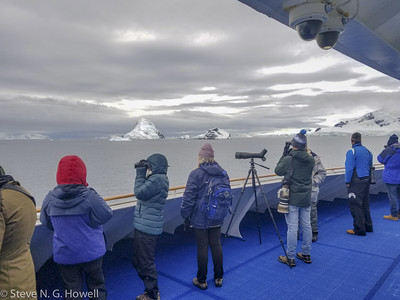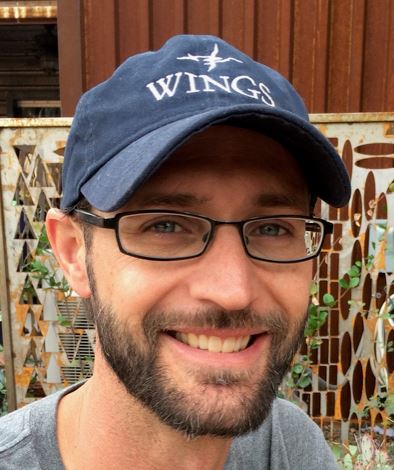
This tour offers a wonderful opportunity for visiting the Great White South in comfort… Photo: Steve Howell
Have you dreamed of taking an extended pelagic trip to the southern tip of South America and cruising off the Antarctic Peninsula—traveling to such legendary places as Cape Horn, the Beagle Channel, the Strait of Magellan, and the Falkland Islands, while seeing up to 8 species of penguins and 8 albatrosses, plus many other species of tubenoses? If so, you may not have imagined that this can be done brilliantly on a Princess cruise ship which is of course both comfortable and well-appointed and is also stable enough to permit telescope use even in these turbulent waters. We believe that this cruise offers the best access to a unique and memorable seabirding experience in South America and probably one of the best in the world.
Now that we have your attention, we should also say that, in addition to spending six full days at sea, we’ll arrange land-based expeditions to such intriguing areas as the Patagonian steppe around Punta Arenas, the penguin colonies on the Falklands, and the wetlands near Montevideo. During our landings we’ll look for specialties such as Magellanic Plover near Punta Arenas; Magellanic Woodpecker near Ushuaia; King Penguin, Falkland Steamer-Duck, and Ruddy-headed Goose on the Falklands; and Giant Wood-Rail and White-throated Hummingbird near Montevideo.
The short pre-tour extension in Argentina will sample the birds of the Ceibas area, north of Buenos Aires, with an impressive diversity of landbirds, especially the ovenbirds (Furnariidae) that characterize South America. Details on booking space with both WINGS and Princess Cruises can be found here.
Pre-tour Extension: Ceibas, Argentina.
We’ll take advantage of being in Argentina by visiting the Ceibas area, which comprises an extremely birdy mix of pampas and espinal habitat not too far from Buenos Aires.
Pre-tour Extension Itinerary:
Day 1: The pre-cruise extension begins this evening in Buenos Aires. Night in Buenos Aires.
Day 2: With an early start to beat the heat, we’ll drive north to the Ceibas area, where birding is excellent in a variety of habitats, especially wetlands and espinal scrubland. In this remarkably rich area more than 100 species are often seen in a single morning, including such birds as Giant Wood-Rail, Long-winged Harrier, Nacunda Nighthawk, White-fronted Woodpecker, Scimitar-billed Woodcreeper, Lark-like Brushrunner, Chotoy Spinetail, White Monjita, White-naped Xenopsaris, and Red-crested Cardinal. Birding will be easy in this semi-open habitat, and we’re certain to have some outstanding photo opportunities. After lunch we’ll head back to Buenos Aires in good time for some rest before dinner.. Night in Buenos Aires.
Day 3 (Day 1 of the Cruise): We’ll spend the early morning birding at Costanera Sur Reserve, close to the harbor. Species that are possible to see in even a short visit include Southern Screamer, Rosy-billed Pochard, Gilded Sapphire, Checkered Woodpecker, Narrow-billed Woodcreeper, Masked Gnatcatcher, and Black-and-rufous Warbling-finch. After check-out and lunch in Buenos Aires we will board the ship and spend the afternoon familiarizing ourselves with the vessel.
Cruise Itinerary: (subject to minor modifications when the actual schedule is released for 2026).
Day 1 (Day 3 of the Pre-tour Extension): The cruise begins with boarding our ship in Buenos Aires, where we’ll become acquainted with our new home for the next two weeks. Depending on the schedule of ship procedures (such as emergency drills) we’ll plan a group meeting on the bow at 6:00 p.m. The ship is scheduled to sail in late afternoon for points south.
Days 2-3: We’ll have two days moving south over Patagonian Shelf waters off the coast of Argentina, where we’ll find our first tubenoses, predominantly non-breeding Great Shearwaters (from Tristan da Cunha) and wintering Manx Shearwaters (from western Europe), among which we will look for Cory’s and Cape Verde Shearwaters, two other trans-hemispheric migrants from islands off northwest Africa. Other tubenose species here include Atlantic Yellow-nosed and Black-browed Albatrosses, White-chinned Petrel, Fuegian [Wilson’s] Storm-petrels, and perhaps Southern Royal Albatross, Spectacled Petrel, or Atlantic Petrel, plus wintering Long-tailed Jaegers from the Arctic tundra—it’s a real mixing ground of seabirds. Mammals may include several species of dolphin plus Southern Right Whale.
Day 4: We’ll have a day to explore the Patagonian steppe around Punta Arenas, where our main target will be the bubblegum-pink-legged Magellanic Plover, the lone species in its family. We’ll have a good chance of finding Darwin’s [Lesser] Rhea, Upland Goose, Two-banded Plover, Austral Negrito, and Black-faced Ibis, among many others. Lakes and wetlands are home to several waterfowl species including Crested Duck, Yellow-billed Pintail, Red Shoveler, and the odd Coscoroba Swan, as well as Chilean Flamingo and Silvery Grebe. We depart in the afternoon, out into the Magellan Strait and head for Ushuaia.
Day 5: We’ll arrive early in the morning in Ushuaia, the southernmost town in the world, where we’ll spend most of our time in Tierra del Fuego National Park with its fantastic Nothofagus (“false beech”) forest and scenic lakes. Birds here include Great Grebe, Flying and Flightless Steamer-Ducks, Black-chested Buzzard-Eagle, Thorn-tailed Rayadito, Patagonian Sierra-finch, Austral Parakeet, and the impressive Magellanic Woodpecker— although we are by no means guaranteed to find this superb bird. In contrast to the stunning landscapes surrounding Ushuaia, we’ll also visit the garbage dump, looking for White-throated Caracara, and the coastal areas that host Kelp Goose and Dolphin Gull. The ship departs Ushuaia in the afternoon, sailing into the Beagle Channel towards Cape Horn.
Day 6: In the morning we’ll approach the Cape Horn archipelago, where Black-browed Albatrosses and Sooty Shearwaters should be swarming around us, and, weather permitting, we’ll round the Cape and be close enough to see the famous albatross monument that marks this special place of history and legend. From Cape Horn we’ll head south into the Drake Passage, bound for Antarctica, with the chance for Blue Petrels in late afternoon, along with perhaps a Gray-headed or Light-mantled Sooty Albatross and our first Snowy Wandering Albatross.
Day 7: We’ll spend a full day at sea as we head towards the Antarctic Peninsula, crossing the Antarctic Convergence at some point during our crossing of the Drake Passage. Among the common Black-browed Albatrosses we should find the less numerous Grey-headed Albatross, plus a few Snowy Wandering and Southern Royal Albatrosses, and with luck the handsome Light-mantled Sooty Albatross. Smaller seabirds will also be interesting, including Slender-billed and Antarctic Prions, Pintado and Blue Petrels, Black-bellied Storm-Petrel, and perhaps Common Diving-Petrel. Fin Whale and Hourglass Dolphin are also distinct possibilities in these waters.
Days 8-11:We should reach the South Shetland islands on the afternoon of Day 8 and head back northwards on Day 11. In between, the days are described in the Princess Cruises literature as “Antarctic Peninsula (Scenic Cruising)” and where we go and what we see will depend on ice and weather conditions, which are notoriously unpredictable. There will no opportunity to land on the Antarctic continent, and we suspect the ship’s captain will be wary of approaching too close to areas with too much ice. Nonetheless, we’ll experience some of the ‘Great White South’ at a fraction of the cost of other trips to this part of the world. There aren’t too many bird species this far south, but the ever-changing scenery can be mesmerizing, and stunning sights of glaciers and blue icebergs may keep you out on deck longer than you think!
Birding opportunities and birds around the Antarctic Peninsula are dependent on ice conditions, and the often-calm seas and absence of open ocean mean that few larger tubenoses are found here. We should see Chinstrap, Gentoo, and Adelie Penguins, South Polar and Subantarctic Brown Skuas, Antarctic Tern, Wilson’s Storm-Petrel, Antarctic Fulmar, and perhaps with luck the ethereal Snow Petrel. There is even a slim chance for Emperor Penguin and Antarctic Petrel, two sought-after icons of the region. We should see numerous Humpback and Antarctic Minke whales, and we’ll be on the lookout for pods of Killer whales, which roam these waters. The ice floes may also host some Weddell Seals and perhaps even a Leopard Seal or two.
Day 12: At sea heading northeast towards the Falklands we’ll watch the pelagic species switch from those of cold Antarctic waters to those of subantarctic waters. Leaving behind Pintado Petrels and Antarctic Fulmars we’ll encounter Slender-billed Prions and, with luck, the diminutive Gray-backed Storm-petrel among a variety of other tubenoses. This can also be a good stretch for mammals, including Sei Whale and perhaps even some beaked whales!
Day 13: We’ll arrive in the Falklands’ capital, Stanley, in early morning. Tenders (the ship’s lifeboats) will take us ashore, where we’ll meet our drivers and head to Volunteer Point. It is a longish drive, partly on a fairly rough track, but we’ll be rewarded by a large mixed colony of King, Gentoo, and Magellanic Penguins. Other species seen here can include Upland and Ruddy-headed Geese, Two-banded Plover, Rufous-chested Dotterel, Falkland Steamer-Duck, Dark-faced Ground-Tyrant, and—with some more luck—even a few Falkland (White-bridled) Finches. After our return to Stanley, we should have enough time to enjoy some shopping or a beer in a truly British pub. Our ship will depart in the evening headed for points northward, and we may want to be on deck looking for albatrosses, petrels, whales, and dolphins as we leave this British Overseas Territory.
Days 14-15: We’ll have two full days at sea en route from the Falkland Islands to Uruguay, including some deeper offshore waters not visited on our southward route. Soft-plumaged Petrel and Atlantic Petrel are often the commonest species on this transect, along with thousands of shearwaters when we reach shallower waters. The supporting cast in this poorly known region includes Atlantic Yellow-nosed Albatross, Spectacled Petrel, and the enigmatic Gough [Black-bellied] Storm-petrel, along with a chance for Great-winged and Gray Petrels, and perhaps Gough Wandering Albatross or a Sooty Albatross.
Day 16: We’ll spend all day in Montevideo’s surroundings, where Monk Parakeet, Rufous Hornero, and Picazuro Pigeon are common. At nearby wetlands, we’ll scan for shorebirds and gulls we have not yet seen, and in the reedbeds and shrubs we’ll look for Rufous-sided Crake, Great Pampa-finch, Spectacled Tyrant, and Freckle-breasted Thornbird. In more shrubby habitat, we have good chance of finding Green-barred Woodpecker, White-crested Tyrannulet, Short-billed Elaenia, White-throated Hummingbird, and—with some luck—even a Rufous-capped Antshrike. In the evening we’ll set sail across the Rio de La Plata river for return to Buenos Aires.
Day 17: We’ll disembark this morning in Buenos Aires, in good time to catch international flights home.
Created: 25 January 2024
Prices
- 2026 Tour Price Not Yet Known
Notes

Questions? Tour Manager: Matt Brooks. Call 1-866-547-9868 (US or Canada) or (01) 520-320-9868 or click here to email.
* Tour invoices paid by check carry a 4% discount. Details here.
* The cruise price noted above covers only the four land excursions during the cruise plus the leaders’ time on-board ship. It does not include your berth on the ship, which must be booked directly with Princess Cruises. Details on booking space with both WINGS and Princess Cruises can be found here.
** In 2026 the cruise will start and end in Buenos Aires.
Maximum group size 14 plus leaders.
